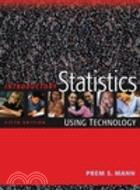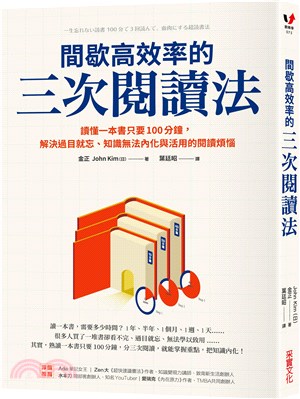INTRODUCTORY STATISTICS 5/E
- ISBN13:9780471473244
- 出版社:JOHN WILEY & SONS;INC.
- 作者:MANN
- 裝訂:平裝
- 出版日:2004/01/01
相關商品
商品簡介
目次
商品簡介
Through four previous editions, Introductory Statistics has made statistics both interesting and accessible to a wide varied audience. The realistic content of its examples and exercises, the clarity and brevity of its presentation, and the soundness of its pedagogical approach have received the highest remarks from both students and instructors, Now this bestseller is available in a new technology version for instructors who want increased integration of technology into their introductory course.
目次
Chapter 1: Introduction.
1.1 What is Statistics.
1.2 Types of Statistics.
Case Study 1-1. Collegians Charge On.
1.3 Population vs. Sample.
Case Study 1-2. Most Do Not Know Their Mail Carrier.
Case Study 1-3. Yes, Looks Can Kill Your Chance for a Job.
1.4 Basic Terms.
1.5 Types of Variables.
1.6 Cross-Section vs. Time-Series Data.
1.7 Sources of Data.
1.8 Summation Notation.
*Uses & Misuses.
*Glossary.
*Supplementary Exercises.
*Self Review Test.
*Mini Project.
Chapter 2: Organizing Data.
2.1 Raw Data.
2.2 Organizing and Graphing Qualitative Data.
Case Study 2-1. If You Are Productive, It Must Be Tuesday.
Case Study 2-2. Favorite Donut Flavors.
2.3 Organizing and Graphing Quantitative Data.
Case Study 2-3. Graduates in Debt.
2.4 Shapes of Histograms.
Case Study 2-4. using Truncated Axes.
2.5 Cumulative Frequency Distributions.
2.6 Stem-and-Leaf Displays.
Chapter 3: Numerical Descriptive Measures.
3.1 Measures of Central Tendency for Ungrouped Data.
Case Study 3-1. Lifespan of $1 Bill: 18 Months.
Case Study 3-2. Education and Earnings.
3.2 Measures of Dispersion for Ungrouped Data.
3.3 Mean, Variance, and Standard Deviation for Grouped Data.
Case Study 3-3. Here Comes the SD.
3.4 Use of Standard Deviation.
3.5 Measures of Position.
3.6 Box-and-Whisper Plot.
Chapter 4: Probability.
4.1 Experiment, Outcomes & Sample Space.
4.2 Calculating Probability.
4.3 Counting Rule.
4.4 Marginal & Conditional Probabilities.
Case Study 4-1. Facing a Crowd Isn't Easy.
4.5 Mutually Exclusive Events.
4.6 Independent vs. Dependent Events.
4.7 Complementary Events.
4.8 Intersection of Events & the Multiplication Rule.
Case Study 4-2. Baseball Players Have "Slumps" and "Streaks".
4.9 Union of Events and the Addition Rule.
Chapter 5: Discrete Random Variables & Their Probability Distributions.
5.1 Random Variables.
5.2 Probability Distribution of a Discrete Random Variable.
5.3 Mean of a Discrete Random Variable.
5.4 Standard Deviation of a Discrete Random Variable.
Case Study 5-1. Aces High Instant Lottery Game.
5.5 Factorials and Combinations.
Case Study 5-2. Playing Lotto.
5.6 The Binomial Probability Distribution.
5.7 The Hypergeometric Probability Distribution.
5.8 The Poisson Probability Distribution.
Case Study 5-3. Ask Mr. Statistics.
Chapter 6: Continuous Random Variables and the Normal Distribution.
6.1 Continuous Probability Distribution.
Case Study 6-1. Distribution of Time Taken to Run a Road Race.
6.2 The Normal Distribution.
6.3 The Standard Normal Distribution.
6.4 Standardizing a Normal Distriution.
6.5 Applications of the Normal Distribution.
6.6 Determining the z and x Values When an Area Under the Normal Distribution Curve is Known.
6.7 The Normal Approximation to the Binomial Distribution.
Chapter 7: Sampling Distributions.
7.1 Population and Sampling Distributions.
7.2 Sampling and Non-Sampling Errors.
7.3 Mean and Standard Deviation of x.
7.4 Shape of the Sampling Distribution x.
7.5 Applications of the Sampling Distribution of x.
7.6 Population and Sample Proportions.
7.7 Mean, Standard Deviation, and Shape of the Sampling Distribution of p.
Case Study 7-1. Calling the Vote for Congress.
Chapter 8: Estimation of the Mean and Proportion.
8.1 Estimation: An Introduction.
8.2 Point and Interval Estimates.
8.3 Interval Estimation of a Population Mean: Large Samples.
Case Study 8-1. Where Your Energy Dollar Goes.
8.4 Interval Estimation of a Population Proportion: Small Samples.
Case Study 8-2. Cardiac Demands of Heavy Snow Shoveling.
8.5 Interval Estimation of a Population Proportion: Large Samples.
Case Study 8-3. What Is Causing Job Stress?
8.6 Determining the Sample Size for the Estimation of Mean.
8.7 Determining the Sample Size for the Estimation of Proportion.
Chapter 9: Hypothesis Tests About the Mean and Proportion.
9.1 Hypothesis Tests: An Introduction.
9.2 Hypothesis Tests About µ for Large samples Using the p-Value Approach.
9.3 Hypothesis Tests About a Population Mean: Large Samples.
9.4 Hypothesis Tests About a Population Mean: Small Samples.
9.5 Hypothesis Tests About a Population Proportion: Large Samples
Case Study 9-1. Employees' Concerns.
Chapter 10: Estimation & Hypothesis Testing: Two Populations.
10.1 Inferences About the Difference Between Two Population Means For Large and Independent Samples.
10.2 Inferences About the Difference Between Two Populations Means for Small and Independent Samples: Equal Standard Deviations.
10.3 Inferences About the Difference Between Two Population Means for Small and Independent Samples: Unequal Standard Deviations.
10.4 Inferences About the Difference Between Two Population Means for Paired Samples.
10.5 Inferences About the Difference Between Two Population Proportions for Large and Independent Samples.
Case Study 10-1. Teenagers Butt Out of Smoking.
Chapter 11: Chi Square Tests.
11.1 The Chi Square Distribution.
11.2 A Goodeness-of-Fit Test.
Case Study 11-1. Up with "the Color Purple".
11.3 Contingency Tables.
11.4 A Test of Independence or Homogeneity.
11.5 Inferences About the Population Variance.
Chapter 12: Analysis of Variance.
12.1 The F Distribution.
12.2 One-Way Analysis of Variance.
Chapter 13: Simple Linear Regression.
13.1 Simple Linear Regression Model.
13.2 Simple Linear Regression Analysis.
13.3 Standard Deviation of Random Errors.
13.4 Coefficient of Determination.
13.5 Inferences About B.
13.6 Linear Correlation.
13.7 Regression Analysis: A Complete Example.
13.8 Using the Regression Model.
13.9 Cautions in Using Regression.
Chapter 14: Nonparametric Methods.
14.1 The Sign Test.
14.2 The Wilcoxon Signed-Rank Test for Two Dependent Samples.
14.3 The Wilcoxon Rank Sum Test for Two Independent Samples.
14.4 The Kruskal-Wallis Test.
14.5 The Spearman Rho Rank Correlation Coefficient Test.
14.6 The Runs Test for Randomness.
Appendix A: Sample Surveys, Sampling Techniques, and Design Experiments.
A.1 Sources of Data.
A.1.1 Internal Sources.
A.1.2 External Sources.
A.1.3 Surveys and Experiments.
A.2 Sample Surveys and Sampling Techniques.
A.2.1 Why Sample.
A.2.2 Random and Nonrandom Samples.
A.2.3 Sampling and Nonsampling Errors.
A.2.4 Random Sampling Techniques.
A.3 Design of Experiments.
Appendix B: Explanation of Data Sets.
Data Set I: City Data.
Data Set II: Data On States.
Data Set III: NBA Data.
Data Set IV: Population Data on Manchester Road Race.
Data Set V: Sample of 500 Observations Selected from Manchester Road Race Data.
Appendix C: Statistical Tables.
I Table of Binomial Probabilities.
II Values of e-.
III Table of Poisson Probabilities.
IV Standard Normal Distribution Table.
V The t Distribution Table.
VI Chi-Square Distribution Table.
VII The F Distribution Table.
VIII Critical Values of X for the Sign Test.
IX Critical Values of T for the Wilcoxon Signed-Rank Test.
X Critical Values of T for the Wilcoxon Rank Sum Test.
XI Critical Values for the Spearman Rho Rank Correlation Coefficient Test.
XII Critical Values for a Two-Tailed Runs Test with à = .05.
ANSWERS TO SELECTED ODD-NUMBERED EXERCISES AND SELF-REVIEW TESTS.
PHOTO CREDITS.
INDEX.
1.1 What is Statistics.
1.2 Types of Statistics.
Case Study 1-1. Collegians Charge On.
1.3 Population vs. Sample.
Case Study 1-2. Most Do Not Know Their Mail Carrier.
Case Study 1-3. Yes, Looks Can Kill Your Chance for a Job.
1.4 Basic Terms.
1.5 Types of Variables.
1.6 Cross-Section vs. Time-Series Data.
1.7 Sources of Data.
1.8 Summation Notation.
*Uses & Misuses.
*Glossary.
*Supplementary Exercises.
*Self Review Test.
*Mini Project.
Chapter 2: Organizing Data.
2.1 Raw Data.
2.2 Organizing and Graphing Qualitative Data.
Case Study 2-1. If You Are Productive, It Must Be Tuesday.
Case Study 2-2. Favorite Donut Flavors.
2.3 Organizing and Graphing Quantitative Data.
Case Study 2-3. Graduates in Debt.
2.4 Shapes of Histograms.
Case Study 2-4. using Truncated Axes.
2.5 Cumulative Frequency Distributions.
2.6 Stem-and-Leaf Displays.
Chapter 3: Numerical Descriptive Measures.
3.1 Measures of Central Tendency for Ungrouped Data.
Case Study 3-1. Lifespan of $1 Bill: 18 Months.
Case Study 3-2. Education and Earnings.
3.2 Measures of Dispersion for Ungrouped Data.
3.3 Mean, Variance, and Standard Deviation for Grouped Data.
Case Study 3-3. Here Comes the SD.
3.4 Use of Standard Deviation.
3.5 Measures of Position.
3.6 Box-and-Whisper Plot.
Chapter 4: Probability.
4.1 Experiment, Outcomes & Sample Space.
4.2 Calculating Probability.
4.3 Counting Rule.
4.4 Marginal & Conditional Probabilities.
Case Study 4-1. Facing a Crowd Isn't Easy.
4.5 Mutually Exclusive Events.
4.6 Independent vs. Dependent Events.
4.7 Complementary Events.
4.8 Intersection of Events & the Multiplication Rule.
Case Study 4-2. Baseball Players Have "Slumps" and "Streaks".
4.9 Union of Events and the Addition Rule.
Chapter 5: Discrete Random Variables & Their Probability Distributions.
5.1 Random Variables.
5.2 Probability Distribution of a Discrete Random Variable.
5.3 Mean of a Discrete Random Variable.
5.4 Standard Deviation of a Discrete Random Variable.
Case Study 5-1. Aces High Instant Lottery Game.
5.5 Factorials and Combinations.
Case Study 5-2. Playing Lotto.
5.6 The Binomial Probability Distribution.
5.7 The Hypergeometric Probability Distribution.
5.8 The Poisson Probability Distribution.
Case Study 5-3. Ask Mr. Statistics.
Chapter 6: Continuous Random Variables and the Normal Distribution.
6.1 Continuous Probability Distribution.
Case Study 6-1. Distribution of Time Taken to Run a Road Race.
6.2 The Normal Distribution.
6.3 The Standard Normal Distribution.
6.4 Standardizing a Normal Distriution.
6.5 Applications of the Normal Distribution.
6.6 Determining the z and x Values When an Area Under the Normal Distribution Curve is Known.
6.7 The Normal Approximation to the Binomial Distribution.
Chapter 7: Sampling Distributions.
7.1 Population and Sampling Distributions.
7.2 Sampling and Non-Sampling Errors.
7.3 Mean and Standard Deviation of x.
7.4 Shape of the Sampling Distribution x.
7.5 Applications of the Sampling Distribution of x.
7.6 Population and Sample Proportions.
7.7 Mean, Standard Deviation, and Shape of the Sampling Distribution of p.
Case Study 7-1. Calling the Vote for Congress.
Chapter 8: Estimation of the Mean and Proportion.
8.1 Estimation: An Introduction.
8.2 Point and Interval Estimates.
8.3 Interval Estimation of a Population Mean: Large Samples.
Case Study 8-1. Where Your Energy Dollar Goes.
8.4 Interval Estimation of a Population Proportion: Small Samples.
Case Study 8-2. Cardiac Demands of Heavy Snow Shoveling.
8.5 Interval Estimation of a Population Proportion: Large Samples.
Case Study 8-3. What Is Causing Job Stress?
8.6 Determining the Sample Size for the Estimation of Mean.
8.7 Determining the Sample Size for the Estimation of Proportion.
Chapter 9: Hypothesis Tests About the Mean and Proportion.
9.1 Hypothesis Tests: An Introduction.
9.2 Hypothesis Tests About µ for Large samples Using the p-Value Approach.
9.3 Hypothesis Tests About a Population Mean: Large Samples.
9.4 Hypothesis Tests About a Population Mean: Small Samples.
9.5 Hypothesis Tests About a Population Proportion: Large Samples
Case Study 9-1. Employees' Concerns.
Chapter 10: Estimation & Hypothesis Testing: Two Populations.
10.1 Inferences About the Difference Between Two Population Means For Large and Independent Samples.
10.2 Inferences About the Difference Between Two Populations Means for Small and Independent Samples: Equal Standard Deviations.
10.3 Inferences About the Difference Between Two Population Means for Small and Independent Samples: Unequal Standard Deviations.
10.4 Inferences About the Difference Between Two Population Means for Paired Samples.
10.5 Inferences About the Difference Between Two Population Proportions for Large and Independent Samples.
Case Study 10-1. Teenagers Butt Out of Smoking.
Chapter 11: Chi Square Tests.
11.1 The Chi Square Distribution.
11.2 A Goodeness-of-Fit Test.
Case Study 11-1. Up with "the Color Purple".
11.3 Contingency Tables.
11.4 A Test of Independence or Homogeneity.
11.5 Inferences About the Population Variance.
Chapter 12: Analysis of Variance.
12.1 The F Distribution.
12.2 One-Way Analysis of Variance.
Chapter 13: Simple Linear Regression.
13.1 Simple Linear Regression Model.
13.2 Simple Linear Regression Analysis.
13.3 Standard Deviation of Random Errors.
13.4 Coefficient of Determination.
13.5 Inferences About B.
13.6 Linear Correlation.
13.7 Regression Analysis: A Complete Example.
13.8 Using the Regression Model.
13.9 Cautions in Using Regression.
Chapter 14: Nonparametric Methods.
14.1 The Sign Test.
14.2 The Wilcoxon Signed-Rank Test for Two Dependent Samples.
14.3 The Wilcoxon Rank Sum Test for Two Independent Samples.
14.4 The Kruskal-Wallis Test.
14.5 The Spearman Rho Rank Correlation Coefficient Test.
14.6 The Runs Test for Randomness.
Appendix A: Sample Surveys, Sampling Techniques, and Design Experiments.
A.1 Sources of Data.
A.1.1 Internal Sources.
A.1.2 External Sources.
A.1.3 Surveys and Experiments.
A.2 Sample Surveys and Sampling Techniques.
A.2.1 Why Sample.
A.2.2 Random and Nonrandom Samples.
A.2.3 Sampling and Nonsampling Errors.
A.2.4 Random Sampling Techniques.
A.3 Design of Experiments.
Appendix B: Explanation of Data Sets.
Data Set I: City Data.
Data Set II: Data On States.
Data Set III: NBA Data.
Data Set IV: Population Data on Manchester Road Race.
Data Set V: Sample of 500 Observations Selected from Manchester Road Race Data.
Appendix C: Statistical Tables.
I Table of Binomial Probabilities.
II Values of e-.
III Table of Poisson Probabilities.
IV Standard Normal Distribution Table.
V The t Distribution Table.
VI Chi-Square Distribution Table.
VII The F Distribution Table.
VIII Critical Values of X for the Sign Test.
IX Critical Values of T for the Wilcoxon Signed-Rank Test.
X Critical Values of T for the Wilcoxon Rank Sum Test.
XI Critical Values for the Spearman Rho Rank Correlation Coefficient Test.
XII Critical Values for a Two-Tailed Runs Test with à = .05.
ANSWERS TO SELECTED ODD-NUMBERED EXERCISES AND SELF-REVIEW TESTS.
PHOTO CREDITS.
INDEX.
主題書展
更多主題書展
更多書展本週66折
您曾經瀏覽過的商品
購物須知
為了保護您的權益,「三民網路書店」提供會員七日商品鑑賞期(收到商品為起始日)。
若要辦理退貨,請在商品鑑賞期內寄回,且商品必須是全新狀態與完整包裝(商品、附件、發票、隨貨贈品等)否則恕不接受退貨。

























